Numerous media reports have been forecasting a sharp decline in gasoline and diesel vehicle sales in China, which reflects the developing issues in the world’s largest auto market for many months.
The Driven reported a story on March 30 titled “Legacy auto faces disaster in China with unsellable cars as pollution crunch looms.” Another report from an established auto news platform Electrek also published a report, “ICE car values plummet in China, and it is the canary in the coal mine,” on April 2.
Bloomberg also published a report titled “China Slowly Squeezes Global Carmakers Out of Its Massive Market” on April 3.
Global car sales, China is leading
China is the pioneering major market to hit 25% of EV sales globally. Although the “EV eutopia” Norway already recorded 90% EV in its new car market, its population is relatively small compared to China.
For information, Norway has a population of only 5.4 million. That said, used internal combustion engine vehicles can be effortlessly immersed in the European market with a 500-million population.
In contrast, China cannot easily absorb the excess petrol and diesel cars sold in the country. It sold nearly 27 million vehicles last year, indicating a global market share of 34%.
Unfortunately for legacy automakers, EVs are currently displacing gasoline and diesel cars by significant margins.
In fact, BEV sales in Australia ultimately beat hybrid car sales last month with 6,612 units and a 6.8% market share. In contrast, mild hybrids only had 5,247 sales, per the Federal Chamber of Automotive Industries (FCAI) latest data.
It is indeed problematic for legacy automakers as they have been very sluggish in the EV industry. In fact, none of the legacy brands are producing EVs at scale, per the report.
Legacy automakers cut new car prices by up to 40%
Chinese news platform Jiemian published an article titled “China’s new car price war spills over into second-hand market” on March 17.
“Old-style makers of traditionally-powered cars have decimated prices by as much as 40 percent prices, as the likes of Mercedes-Benz and Chevrolet seek to protect their hard-won market share.”
Jiemien
The report claims that China cut the sales tax on brand-new ICE vehicles in half to boost the market in June 2022. That merely put the problem off, and now dealers are scrambling to get rid of stock.
EVs are forecasted to dominate 35% of the market by the end of 2023
For reference, the EV market share increased by an astounding 93% between 2021 and 2022.
In hindsight, Reuters stated in 2021 that EV sales in China were anticipated to reach 35% in 2025.
Bloomberg also recently predicted that by March 2023, the Chinese market will most likely have achieved that milestone.
Therefore, the market for gasoline and diesel cars would decline by millions considerably sooner than anyone predicted, including legacy auto executives.
Chinese dealerships may hit their limits soon
Chinese dealerships have been absorbing new cars leaving the production lines throughout the past months.
However, they may soon reach their limits considering that the country’s 6b pollution standards may be enacted in the next 12 months, which may further increase EV uptake.
You can check Bloomberg’s graphic presentation here.
The market is now entering the “meaty part” of the slope, with China’s EV market share increasing from 5% to 35% in only three years. In contrast, the market share being reduced for ICE vehicles grows larger and larger each month.
The legacy auto industry is also heavily leveraged.
It might only take a slight decline in sales to push them over the brink.
Risk for legacy automakers like Toyota and VW
Among the most indebted automakers in the world are VW and Toyota.
Toyota and Volkswagen both anticipate waiting until 2027 to begin offering mass-produced EVs.
See Also:
- CPCA: China’s retail sales of passenger NEVs increased 32% from January
- CPCA projects NEV sales in China to surge 20% in February from January
- China: NEV sales grew 106% YoY on February 1 to 12
- China: Passenger NEV retail sales declined 48% in January from December
- China: Sales of plug-in vehicles reached almost 6 million in 2022
That said, it would be interesting to see if they could withstand a consistent 30% sales decline in areas like China.
Furthermore, their market position will be seriously weakened if China’s EV market share reaches 50% in 2024.






